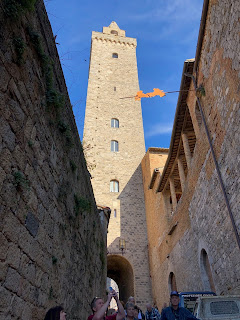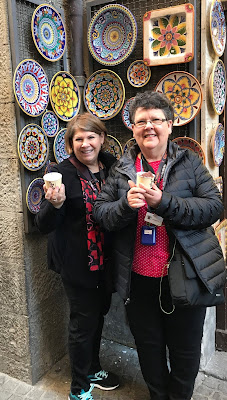Friday, February 15, 2019
Another "from a moving bus" shot taken as we left Florence for a day in the hills of Tuscany.
First stop: Florence American Cemetery and Memorial
"The 4,398 servicemen and four women interred in the cemetery represent 39 percent of the temporary burials originally made between Rome and the Alps. Most died in the fighting which occurred after the capture of Rome in June 1944. Included among them are casualties of the heavy fighting in the Apenninnes Mountains shortly before the war's end."
- Florence American Cemetery Memorial Visitor Booklet
Church of San Francesco
Piazza del Duomo,
the town's Romanesque cathedral
Piazza
della Cisterna, built in 1273, showing the stone imprints of ropes that
were lowered into the well more than 700 years ago.
San Gimignano was a natural stop for pilgrims traveling to or from Rome on the Via Francigena. Today it's a natural stop for tourists complete with the medieval towers, the well in the town center, shopping, views of the Tuscan countryside, and of course gelato.
A scheduled late lunch made this gelato stop absolutely necessary!
Third Stop: Lunch at Bibbiano La Taverna
Third Stop: Lunch at Bibbiano La Taverna
Empty plates, happy diners!
San Gimignano from our lunch spot
Back on the bus with Nancy, a lady who loves stars.
This bus was made for her!
Fourth Stop: Monteriggioni,
an impressive walled Medieval town,
built in 1200
The village, viewed from the bus!
Fifth Stop: Famous Florence viewpoint!
Fifth Stop: Famous Florence viewpoint!
Sixth Stop: Dinner on our own
before evening presentation on Florence
Love an Italian grocery
and these fabulous traveling friends!


































































